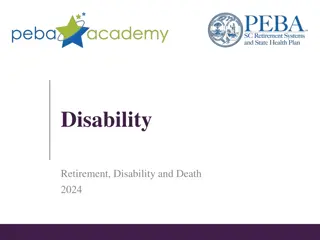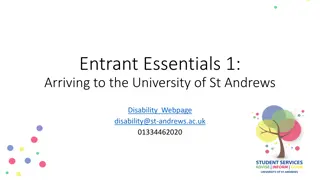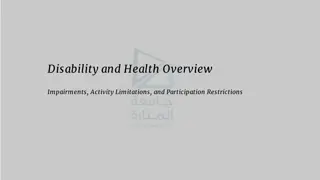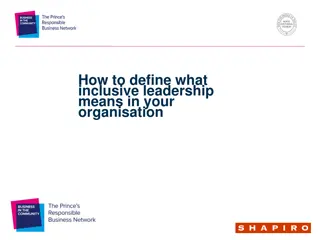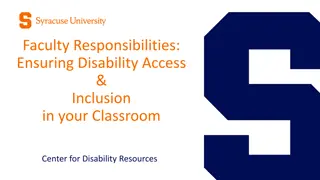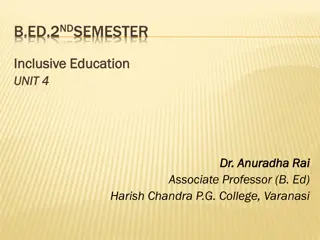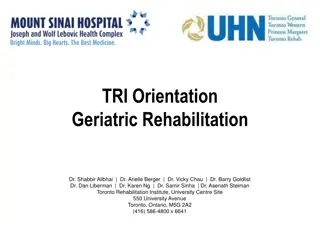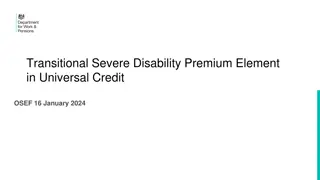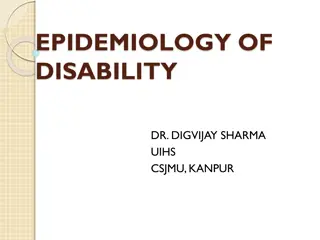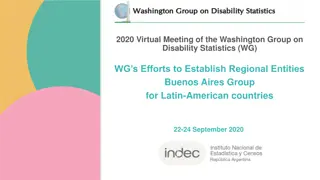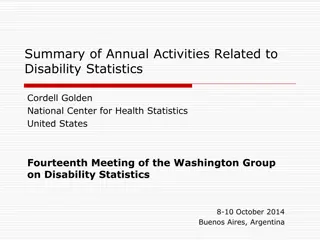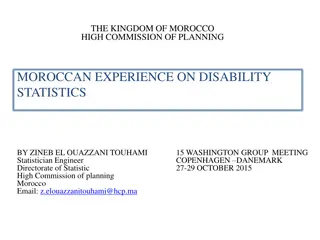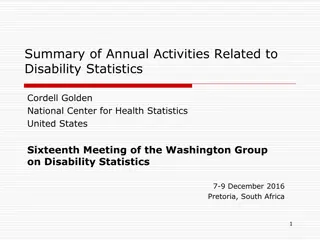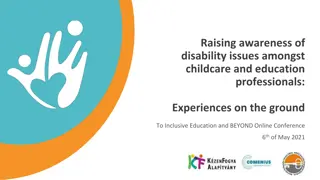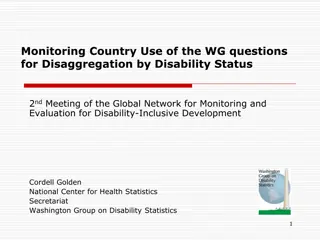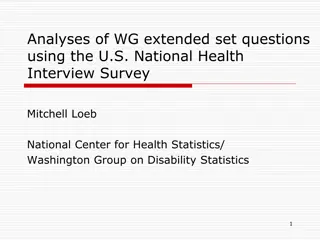International Efforts for Disability-Inclusive Development
Explore Australia's initiatives in enhancing disability statistics, strengthening data collection globally, and promoting disability-inclusive development internationally through partnerships and networks such as GLAD. Learn about surveys on disability prevalence and support for those in need, reflecting a commitment to fostering inclusivity and support for persons with disabilities on a global scale.
Download Presentation

Please find below an Image/Link to download the presentation.
The content on the website is provided AS IS for your information and personal use only. It may not be sold, licensed, or shared on other websites without obtaining consent from the author.If you encounter any issues during the download, it is possible that the publisher has removed the file from their server.
You are allowed to download the files provided on this website for personal or commercial use, subject to the condition that they are used lawfully. All files are the property of their respective owners.
The content on the website is provided AS IS for your information and personal use only. It may not be sold, licensed, or shared on other websites without obtaining consent from the author.
E N D
Presentation Transcript
Sharing Australias experiences: Disability statistics nationally and internationally Washington Group on Disability Statistics (WG16) Pretoria, December 2016 Katie Magee Assistant Director, Disability Section Development Policy and Education Branch Development Policy Division
Development for All 2015-2020: Strategy for strengthening disability-inclusive development in Australia s aid program
International disability partnerships Australian Development Research Awards Scheme UN Special Rapporteur on the Rights of Persons with Disabilities
Strengthening disability data collection and analysis globally
Global Action on Disability (GLAD) Network The GLAD Network is an international group of donors, multilateral agencies, foundations and philanthropic organisations, and private sector entities actively contributing resources internationally to disability inclusive development GLAD promotes international cooperation on disability-inclusive development DFAT and IDA co-chairs of GLAD in 2016-17 GLAD Steering Committee meeting held in New York in June 2016 GLAD Network meeting in Berlin in March 2017 Photo: DFAT Photo/Miller Lokanata
Sharing Australias experiences disability statistics nationally and internationally Suraksha Maharaj Director Disability, Ageing and Carers National Statistical Centre
Survey of Disability, Ageing and Carers Prevalence of disability in Australia Socioeconomic information Carers information Demographic information Older Australians Need for support of those with disability
The 2016 Supplementary Disability Survey The 2016 SDS was conducted in collaboration with the Australian Department of Foreign Affairs and Trade to provide an internationally comparable disability measure for Australia Washington Group Short Set on Functioning questions Voluntary follow-up survey, sampled from SDAC 6,213 households (13,837 people) Computer-assisted telephone interviews
The 2016 Supplementary Disability Survey Respondents were asked about their level of difficulty because of a health problem Weights calculated based on SDAC 2015 Estimated resident population benchmarks (ERP) and person level benchmarks from the SDAC
Comparing disability surveys When comparing disability prevalence rates from Australia it s important to be aware of the different approaches used SDAC SDS WG Short Set Age All ages Aged 5 years and over Adult population Scope Households and establishments Computer-assisted personal interviews Households only Interview method Computer-assisted telephone interviews Face-to-face Respondent Any adult followed by personal interviews or proxy interviews Adult providing information on behalf of household Individual (self-response) Number of questions Up to 150 6 questions 6 questions
Results from Australias WG survey 6.7% of Australians reported disability 5.9% of males 7.3% of females
Results from Australias WG survey As expected, the WG disability prevalence increased with age 90% 80% 70% 60% 50% 43% 40% 30% 24% 20% 12% 9% 10% 4% 3% 2% 2% 0% 18 - 24 25 - 34 35 - 44 45 - 54 55 - 64 65 - 74 75 - 84 Age group (years) 85+
Results from Australias WG survey 9.5% of those living outside of capital cities had disability 5.3% of those living in capital cities had disability
Results from Australias WG survey Disability prevalence varied across the six WG domains Domain % Seeing 0.9% Hearing 1.6% Walking or climbing stairs 4.1% Remembering or concentrating 1.6% Self care 0.9% Communication 0.6% People with disability are those who reported a lot of difficulty or cannot do at all.
Lessons from the field Interviews were, on average, 2.9 minutes per household Some interviewers noted comprehension concerns, for example needing to reinforce and repeat the statement even if wearing glasses or wearing a hearing aid The mobility module was reportedly well understood Interviewers suspected under-reporting of difficulty for remembering and concentrating with respondents sharing experiences of having difficulty then often answering No difficulty Some interviewers would have preferred more information on the WG and modules
Comparing Australias WG and SDAC results The SDAC identified just over 4 million Australians as having a disability, while the WG questions gave an estimate of 1.3 million The positive and negative predictive values of the WG questions were both 85%, indicating that when the WG questions identified someone with or without disability, this was usually correct SDAC with disability 85% SDAC without disability 15% Total 100% WG with disability WG without disability Total 15% 85% 100% 100% 19% 81%
Comparing Australias WG and SDAC results The sensitivity was low at 26%, indicating the WG questions missed a large portion of the population who live with disability In contrast specificity was high at 99%, indicating the WG questions could accurately identify those who do not live with disability SDAC with disability 26% SDAC without disability 1% Total 6% WG with disability WG without disability Total 74% 99% 94% 100% 100% 100%
Comparing Australias WG and SDAC results For people that SDAC identified as having a loss of hearing, the WG questions identified around 34% of this group as living with disability Disability Type % Loss of hearing 34% Difficulty learning or understanding things 37% Speech difficulties 47% Loss of sight 50% Incomplete use of feet or legs 51% Memory problems or periods of confusion 64%
Comparing Australias WG and SDAC results For people that SDAC identified as having a loss of sight, the WG questions identified around 50% of this group as living with disability Disability Type % Loss of hearing 34% Difficulty learning or understanding things 37% Speech difficulties 47% Loss of sight 50% Incomplete use of feet or legs 51% Memory problems or periods of confusion 64%
Comparing Australias WG and SDAC results For people that SDAC identified as having memory problems or periods of confusion, the WG questions identified around 64% of this group as living with disability Disability Type % Loss of hearing 34% Difficulty learning or understanding things 37% Speech difficulties 47% Loss of sight 50% Incomplete use of feet or legs 51% Memory problems or periods of confusion 64%
Comparing Australias WG and SDAC results As severity of disability increased so too did the WG questions ability to correctly identify someone as living with disability 80% 70% 60% 50% 40% 30% 20% 10% 0% Profound Severe Moderate Mild Schooling or employment restriction only No specific limitation LTHC but no disability No disability and no LTHC
Comparing Australias WG and SDAC results The WG questions were better able to detect disability in those in lower socioeconomic groups and in older age groups 45% Socioeconomic status 45% Age 40% 40% 35% 35% 30% 30% 25% 25% 20% 20% 15% 15% 10% 10% 5% 5% 0% 0% Q1 Q2 Q3 Q4 Q5 0 - 14 15 - 34 35 - 54 55 - 74 75+ More disadvantage
Comparing Australias WG and SDAC results There were also some interaction effects Disability Type Males Females Nervous or emotional condition 29% 36% Difficulty gripping or holding things 41% 36% Loss of hearing 31% 38% Social or behavioural difficulties 36% 41% Speech difficulties 47% 47% Loss of sight 47% 53% Incomplete use of feet or legs 47% 54% Memory problems or periods of confusion 66% 62%
Comparing Australias WG and SDAC results Seeing WG Response No, no difficulty Yes, some difficulty Yes, a lot of difficulty or Cannot do at all 100% 90% Where a person had no loss of sight, WG questions also showed this 80% Where a person had partial or total loss of sight, they fell into a range of WG categories 70% 60% 50% 40% 30% 20% 10% 0% No loss of sight Loss of sight corrected by wearing glasses or contact lenses Partial loss of sight that can't be corrected/ Total loss of sight SDAC Response
Comparing Australias WG and SDAC results Hearing No, no difficulty Yes, some difficulty Yes, a lot of difficulty or Cannot do at all WG Response 100% 90% Where a person had partial or total loss of hearing, they fell into a range of WG categories 80% Where a person had no loss of hearing, WG questions also showed this 70% 60% 50% 40% 30% 20% 10% 0% No loss of hearing or loss of hearing that can be fully corrected Partial or total loss of hearing that can be partly corrected Partial or total loss of hearing that cannot be corrected SDAC Response
Comparing Australias WG and SDAC results Mobility No, no difficulty Yes, some difficulty Yes, a lot of difficulty or Cannot do at all WG Response 100% A mix of responses in people with the most mobility restriction, although the WG performed a little better than the sight and hearing domains 90% 80% Again, here we see high specificity 70% 60% 50% 40% 30% 20% 10% 0% Can easily walk 200 metres and walk up and down stairs without a handrail Has difficulty either walking 200 metres or walking up and down stairs without a handrail Cannot walk 200 meters or walk up and down stairs without a handrail SDAC Response
Comparing Australias WG and SDAC results Cognition No, no difficulty Yes, some difficulty Yes, a lot of difficulty or Cannot do at all WG Response 100% Cognition was one of the domains where the WG questions performed the strongest 90% 80% Again, here we see high specificity 70% 60% 50% 40% 30% 20% 10% 0% No memory problems or confusion Has memory problems or confusion but is not restricted Has memory problems or confusion and is restricted SDAC Response
Comparing Australias WG and SDAC results Self-care No, no difficulty Yes, some difficulty Yes, a lot of difficulty Cannot do at all WG Response 100% 90% Again, here we see high specificity 80% And a range of outcomes where a person has a severe or profound self- care limitation 70% 60% 50% 40% 30% 20% 10% 0% No limitation Mild or moderate limitation Severe limitation Profound limitation SDAC Response
Comparing Australias WG and SDAC results Communication No, no difficulty Yes, some difficulty Yes, a lot of difficulty or Cannot do at all WG Response 100% Communication was the other domain where the WG questions performed the strongest with the highest alignment where people have profound or severe limitation 90% 80% 70% 60% 50% 40% 30% 20% 10% 0% No limitation Mild or moderate limitation Severe limitation Profound limitation SDAC Response
Comparing Australias WG and SDAC Differences in survey methodology may explain some of the observed differences in Australia s WG disability estimates compared to the SDAC We are currently considering what effect the following had: Interview method using a phone interview? Respondent answering for all in household? Number of questions 6 compared to an extensive set? Collection mode follow up survey? Question format asking question for each domain of everyone in household before proceeding to next domain? Interviewer training more supporting material for interviewers?
Thank you Contact us disability.statistics@abs.gov.au Suraksha.Maharaj@abs.gov.au



